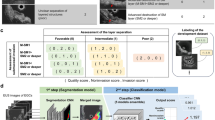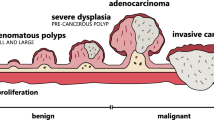Abstract
Background
Various surface mucosal pit patterns, as recognized by endoscopists, correlate with the histologic features of colorectal cancers. We investigated whether magnified endoscopy images of these pit patterns could be analyzed quantitatively and thus facilitate computer-aided diagnosis of colorectal lesions.
Methods
We applied both texture analysis and scale-invariant feature transform (SIFT) descriptors and discriminant analysis to magnified endoscopy images of 165 neoplastic colorectal lesions (pit patterns: type IIIL/IV, n = 44; type VI-mildly irregular, n = 36; type VI-severely irregular, n = 45; type VN, n = 40) [histologic findings: tubular adenoma (TA), n = 56; carcinoma with intramucosal or even scant submucosal invasion (M/SM-s), n = 52, carcinoma with massive submucosal invasion (SM-m), n = 57]. We analyzed differences in pit pattern values and corresponding histologic values to determine whether the values were diagnostically meaningful.
Results
Gray-level difference matrix (GLDM) inverse difference moment and spatial gray-level dependence matrix (SGLDM) local homogeneity values differed significantly between type IIIL/IV and type VN pit patterns. Values differed significantly for each analyzed feature between type IIIL/IV and type VI-severely irregular patterns and were high but descending for type IIIL/IV, type VI-mildly irregular, and type VI-severely irregular pit patterns (in that order). Similarly, texture analysis yielded high but descending values for TA, M/SM-s, and SM-m (in that order). Furthermore, SIFT descriptors and discriminant analysis yielded differences that were superior to those obtained by texture analyses.
Conclusions
Computer analysis of magnified endoscopy images for the diagnosis of colorectal lesions appears feasible. We anticipate further developments in the computer-aided diagnosis of pit patterns on magnified endoscopy images.







Similar content being viewed by others
References
Parkin DM, Bray F, Ferlay J, Pisani P. Global cancer statistics, 2002. CA Cancer J Clin. 2005;55:74–108.
Matsuda T, Zhang M. Comparison of time trends in colorectal cancer mortality (1990–2006) in the world, from the WHO mortality database. Jpn J Clin Oncol. 2009;39:777–8.
Zavoral M, Suchanek S, Zavada F, Dusek L, Muzik J, Seifert B, et al. Colorectal cancer screening in Europe. World J Gastroenterol. 2009;15:5907–15.
Vogelstein B, Fearon ER, Hamilton SR, Kern SE, Preisinger AC, Leppert M, et al. Genetic alterations during colorectal-tumor development. N Engl J Med. 1988;319:525–32.
Winawer SJ, Zauber AG, Ho MN, O’Brien MJ, Gottlieb LS, Sternberg SS, et al. Prevention of colorectal cancer by colonoscopic polypectomy. The National Polyp Study Workgroup. N Engl J Med. 1993;329:1977–81.
Tanaka S, Kaltenbach T, Chayama K, Soetikno R. High-magnification colonoscopy (with videos). Gastrointest Endosc. 2006;64:604–13.
Ueno H, Mochizuki H, Hashiguchi Y, Shimazaki H, Aida S, Hase K, et al. Risk factors for an adverse outcome in early invasive colorectal carcinoma. Gastroenterology. 2004;127:385–94.
Kitajima K, Fujimori T, Fujii S, Takeda J, Ohkura Y, Kawamata H, et al. Correlations between lymph node metastasis and depth of submucosal invasion in submucosal invasive colorectal carcinoma: a Japanese collaborative study. J Gastroenterol. 2004;39:534–43.
Kudo S, Hirota S, Nakajima T, Hosobe S, Kusaka H, Kobayashi T, et al. Colorectal tumours and pit pattern. J Clin Pathol. 1994;47:880–5.
Kudo S, Tamura S, Nakajima T, Yamano H, Kusaka H, Watanabe H. Diagnosis of colorectal tumorous lesions by magnifying endoscopy. Gastrointest Endosc. 1996;44:8–14.
Kudo S, Rubio CA, Teixeira CR, Kashida H, Kogure E. Pit pattern in colorectal neoplasia: endoscopic magnifying view. Endoscopy. 2001;33:367–73.
Kanao H, Tanaka S, Oka S, Kaneko I, Yoshida S, Arihiro K, et al. Clinical significance of type VI pit pattern subclassification in determining the depth of invasion of colorectal neoplasms. World J Gastroenterol. 2008;14:211–7.
Matsumoto K, Nagahara A, Terai T, Ueyama H, Ritsuno H, Mori H, et al. Evaluation of new subclassification of type VI pit pattern for determining the depth and type of invasion of colorectal neoplasm. J Gastroenterol. 2011;46:31–8.
Onishi T, Tamura S, Kuratani Y, Onishi S, Yasuda N. Evaluation of the depth score of type V pit patterns in crypt orifices of colorectal neoplastic lesions. J Gastroenterol. 2008;43:291–7.
Haralick RM, Shanmugan K, Dinstein I. Textural features for image classification. IEEE Trans Syst Man Cybern. 1973;3:610–22.
Haralick RM. Statistical and structural approaches to texture. Proc IEEE. 1979;67:786–804.
Castellano G, Bonilha L, Li LM, Cendes F. Texture analysis of medical images. Clin Radiol. 2004;59:1061–9.
Chen CY, Chiou HJ, Chou SY, Chiou SY, Wang HK, Chou YH, et al. Computer-aided diagnosis of soft-tissue tumors using sonographic morphologic and texture features. Acad Radiol. 2009;16:1531–8.
Muldoon TJ, Thekkek N, Roblyer D, Maru D, Harpaz N, Potack J, et al. Evaluation of quantitative image analysis criteria for the high-resolution microendoscopic detection of neoplasia in Barrett’s esophagus. J Biomed Opt. 2010;15:026027.
Lowe DG. Object recognition from local scale-invariant features. In: Proceedings of the seventh IEEE international conference on computer vision; 1999. p. 1150–7.
Lowe DG. Distinctive image features from scale-invariant keypoints. Int J Comput Vis. 2004;60:91–110.
Carstensen JM. Description and simulation of visual texture. Technical report (Academic Dissertation), Technical University of Denmark. vol. 59; 1992. p. 9–74.
Siew LH, Hodgson RM, Wood EJ. Texture measures for carpet wear assessment. IEEE Trans Pattern Anal Mach Intell. 1988;10:92–105.
Meier A, Farrow C, Harris BE, King GG, Jones A. Application of texture analysis to ventilation SPECT/CT data. Comput Med Imaging Graph. 2011;35:438–50.
Mir AH, Hanmandlu M, Tandon SN. Texture analysis of CT images. IEEE Eng Med Biol Mag. 1995;14:781–6.
Vedaldi A, Fulkerson B. VLFeat: an open and portable library of computer vision algorithms. In: Proceedings of ACM Multimedia; 2010. p. 1469–72.
Bosch A, Zisserman A, Muñoz X. Image classification using random forests and ferns. In: Proceedings of the IEEE 11th international conference on computer vision, Rio de Janeiro, Brazil. vol. 23; 2007. p. 1–8.
Cai D, He X, Han J. SRDA: an efficient algorithm for large-scale discriminant analysis. IEEE Trans Knowl Data Eng. 2008;20:1–12.
Hamilton SR, Aaltonen LA. World Health Organization classification of tumours. Pathology and genetics of tumours of the digestive system. Lyon: IARC Press; 2000. p. 104–19.
Japanese Society for Cancer of the Colon and Rectum. General rules for clinical and pathological studies on cancer of the colon, rectum and anus. 7th ed. Tokyo: Kanehara Shuppan; 2006. (in Japanese).
Togashi K, Konishi F, Ishizuka T, Sato T, Senba S, Kanazawa K. Efficacy of magnifying endoscopy in the differential diagnosis of neoplastic and non-neoplastic polyps of the large bowel. Dis Colon Rectum. 1999;42:602–8.
Kiesslich R, von Bergh M, Hahn M, Hermann G, Jung M. Chromoendoscopy with indigocarmine improves the detection of adenomatous and nonadenomatous lesions in the colon. Endoscopy. 2001;33:1001–6.
Tung SY, Wu CS, Su MY. Magnifying colonoscopy in differentiating neoplastic from nonneoplastic colorectal lesions. Am J Gastroenterol. 2001;96:2628–32.
Fu KI, Sano Y, Kato S, Fujii T, Nagashima F, Yoshino T, et al. Chromoendoscopy using indigo carmine dye spraying with magnifying observation is the most reliable method for differential diagnosis between non-neoplastic and neoplastic colorectal lesions: a prospective study. Endoscopy. 2004;36:1089–93.
Tanaka S, Haruma K, Oh-e H, Nagata S, Hirota Y, Furudoi A, et al. Conditions of curability after endoscopic resection for colorectal carcinoma with submucosally massive invasion. Oncol Rep. 2000;7:783–8.
Tanaka S, Nagata S, Oka S, Kuwai T, Tamura T, Kitadai Y, et al. Determining depth of invasion by VN pit pattern analysis in submucosal colorectal carcinoma. Oncol Rep. 2002;9:1005–8.
Nagata S, Tanaka S, Haruma K, Yoshihara M, Sumii K, Kajiyama G, et al. Pit pattern diagnosis of early colorectal carcinoma by magnifying colonoscopy: clinical and histological implications. Int J Oncol. 2000;16:927–34.
Takemura Y, Yoshida S, Tanaka S, Onji K, Oka S, Tamaki T, et al. Quantitative analysis and development of a computer-aided system for identification of regular pit patterns of colorectal lesions. Gastrointest Endosc. 2010;72:1047–51.
Mikolajczyk K, Schmid C. A performance evaluation of local descriptors. IEEE Trans Pattern Anal Mac Intell. 2005;27:1615–30.
Ke Y, Sukthankar R. PCA-SIFT: a more distinctive representation for local image descriptors. In: Proceedings of the 2004 IEEE Computer Society conference on computer vision and pattern recognition. vol. 2; 2004. p. 506–13.
Dalal N, Triggs B. Histograms of oriented gradients for human detection. In: Proceedings of the 2005 IEEE Computer Society conference on computer vision and pattern recognition (CVPR’05). vol. 1; 2005. p. 886–93.
Acknowledgments
We would like to thank Jyunki Yoshimuta for his work with the calculation of images.
Conflict of interest
The authors declare that they have no conflict of interest.
Author information
Authors and Affiliations
Corresponding author
Rights and permissions
About this article
Cite this article
Onji, K., Yoshida, S., Tanaka, S. et al. Quantitative analysis of colorectal lesions observed on magnified endoscopy images. J Gastroenterol 46, 1382–1390 (2011). https://doi.org/10.1007/s00535-011-0459-x
Received:
Accepted:
Published:
Issue Date:
DOI: https://doi.org/10.1007/s00535-011-0459-x




